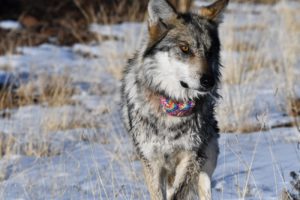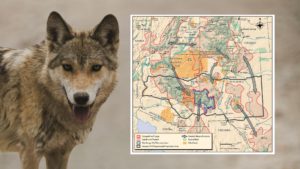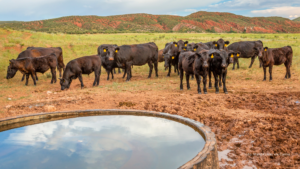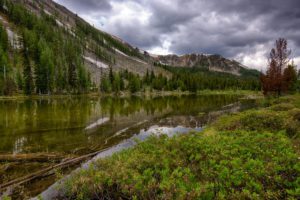For Immediate Release, August 7, 2025
Contact:
- Greta Anderson, Western Watersheds Project, (520) 623-1878, greta@westernwatersheds.org
- Michael Robinson, Center for Biological Diversity, (575) 313-7017, michaelr@biologicaldiversity.org
- Leia Barnett, WildEarth Guardians , (970) 406-2125, Lbarnett@wildearthguardians.org
- Claire Musser, Grand Canyon Wolf Recovery Project, (928) 202-1325, claire@gcwolfrecovery.org
- Regan Downey, Wolf Conservation Center, (914) 763-2373, regan@nywolf.org
- Erin Hunt, Lobos of the Southwest, (928) 421-0187, erin@mexicanwolves.org
- Mary Katherine Ray, Rio Grande Chapter Sierra Club, 575-537-1095 mkrscrim@gmail.com
- Nico Lorenzen, Wild Arizona, (520) 289-0147, nico@wildarizona.org
Captured Mexican Gray Wolf Asha Released With Mate, Pups in New Mexico
SILVER CITY, N.M. — The U.S. Fish and Wildlife Service today released into the wild an endangered Mexican gray wolf called Asha, along with her mate and pups. Asha was featured in National Geographic and other media for twice roaming north of Interstate 40 in New Mexico before being captured and kept in prolonged captivity for having strayed beyond the arbitrary northern boundary of the Mexican Wolf Experimental Population Area.
Asha is a female adult wolf who was released with her captive-born mate Arcadia and their five pups onto the conservation-managed, 244-square-mile Ladder Ranch. The property adjoins the Aldo Leopold Wilderness within the Gila National Forest. The Service named the wolf family the Quartz pack, though conservation groups had previously dubbed them the Caldera Pack in honor of Asha’s journeys to the Valles Caldera National Preserve.
“Asha should never have been punished with a year and a half in captivity for merely wandering north of I-40, but we’re grateful to the agencies for doing the right thing now and setting this family free,” said Greta Anderson, deputy director of Western Watersheds Project. “May her puppies grow up in a world without arbitrary limits on their roaming, and we wish this young family all the best.”
As they mature and eventually breed, the Quartz pack pups have the potential to add genes to the wild population which suffers from low genetic diversity.
“I’m thrilled that Asha is free again along with her captive-born family,” said Michael Robinson, a senior conservation advocate at the Center for Biological Diversity. “Her senseless capturing twice deprived her of the opportunity to find a mate in the Rocky Mountains and expand the Mexican wolf’s range. May her pups grow up with their mom’s intrepid spirit and the savvy that kept her alive across so many miles.”
The Quartz pack was released six weeks after they were originally scheduled to be freed in June, and only after 8,000 citizens emailed and 36 conservation organizations wrote the Service and the Department of the Interior in July seeking their immediate release.
The delayed release meant that the captive-born pups missed the best opportunity to become accustomed to their natural prey of elk, which Mexican wolves typically learn to hunt in June and early July when elk calves abound.
“Asha’s story should have continued in northern New Mexico where her instincts led her to travel twice — that is historic and future wolf country,” said Leia Barnett, Greater Gila New Mexico advocate for WildEarth Guardians. “But until wildlife management agencies recognize that highways shouldn’t dictate where wildlife lives, Asha and the Quartz pack being released back into the Gila is the next best thing. We celebrate her new family’s next wild chapter.”
“Asha reminds us what it means to be wild; she followed her instincts, not a map. Her release with a mate and pups is a powerful testament to the resilience of wolves, but it’s also a reminder that recovery demands more than relocation,” said Claire Musser, executive director of the Grand Canyon Wolf Recovery Project. “For Mexican gray wolves to truly thrive, they must be treated as active agents in their own recovery. Asha is a wild wolf, not a pet in need of protection; she deserves a wild life, not a managed one. Our duty is not to keep her safe by keeping her confined, but to keep her free by ensuring the landscapes she needs remain wild and connected.”
“The return of Asha to her ancestral home is worth celebrating — the wild has been waiting for her since 2023,” said Regan Downey, director of education and advocacy at the Wolf Conservation Center. “Imagine the excitement and curiosity coursing through the Quartz pack; for Asha, this is a wild homecoming, and for her family, this is the opportunity of a lifetime. Run free, lobos!”
“We are filled with hope that Asha, her mate, Arcadia, and their pups, Kachina, Aspen, Sage, Kai, and Aala, will roam freely for years to come,” said Erin Hunt, managing director of Lobos of the Southwest. “They may not be able to read lines on a map, but these lobos can read the landscape and know where they belong. This young family will have an excellent teacher in their mom Asha, and the wild place they will call home will be better off with their presence.”
“A year and a half is a long time in the life of a wolf, but we can now celebrate that Asha’s extended captivity is over. She, along with her family, are free and wild the way wolves are meant to be,” said Mary Katherine Ray, Wildlife Chair, Rio Grande Chapter of the Sierra Club. “We also celebrate the addition of this wolf family back into wild nature to contribute to the restoration of what was lost when wolves were thoughtlessly exterminated.”
“Asha is a champion of conservation, but not of her own choosing. For the people of the Southwest she represents our rewilding, the hope that a wolf can roam of her own accord and instincts. Her capture reminds us of the challenges that beset that vision while her release is a signal that we, collectively, can still make the right decisions for ourselves, or wild lands, and most of all the animals that cohabit these lands with us.” said Nico Lorenzen of Wild Arizona. “Asha and her family know nothing of this conceptual struggle, all they seek is the ability to travel the land and return to hunt and run on those landscapes that they know best, free from capture and unnecessary outside influence. Let Asha and the Quartz Pack Roam.”
Background
Until the December 2023 Colorado reintroduction of northern gray wolves, who are required to stay within the state, the Mexican gray wolf was the only endangered species required by regulation to stay within politically-derived boundaries. Because of these geographic bans, wild wolves are not allowed from I-40 all the way to the New Mexico–Colorado border. Independent scientists maintain that wolves returning to the southern Rocky Mountains region is vital for the Mexican wolf’s recovery.
###
The Center for Biological Diversity is a national, nonprofit conservation organization with more than 1.7 million members and online activists dedicated to the protection of endangered species and wild places.
The mission of Western Watersheds Project (WWP) is to protect and restore western watersheds and wildlife through education, public policy initiatives, and legal advocacy.
Lobos of the Southwest is a collaborative effort of concerned community members and local, regional, and national conservation, scientific and sportsmen’s organizations working to save the endangered Mexican gray wolf.
WildEarth Guardians is a conservation nonprofit whose mission is to protect and restore the wildlife, wild places, wild rivers, and health of the American West. Guardians has offices in Arizona, Colorado, Idaho, Montana, New Mexico, Oregon, and Washington, and over 179,000 members and supporters worldwide
The Grand Canyon Wolf Recovery Project is dedicated to bringing back wolves to help restore ecological health in the Grand Canyon region, while also recognizing wolves as sentient beings with intrinsic value and worth.
The Sierra Club’s mission is to explore, enjoy, and protect the Earth’s wild places, promote the responsible use of the Earth’s ecosystems and resources, and educate and enlist humanity to protect and restore the quality of the natural and human environment
The Wolf Conservation Center’s mission is to advance the survival of wolves by inspiring a global community through education, advocacy, research, and recovery.
Wild Arizona’s mission is to protect, unite, and restore wild lands and waters across Arizona and beyond, for the enrichment and health of all generations, and to ensure Arizona’s native plants and animals a lasting home in wild nature. We organize and amplify multi-community voices of support for legislation and special designations; advocate for conservation policy and planning based in science; and cultivate stewardship, conservation awareness, and well-being through outdoor volunteerism, science, and education.






